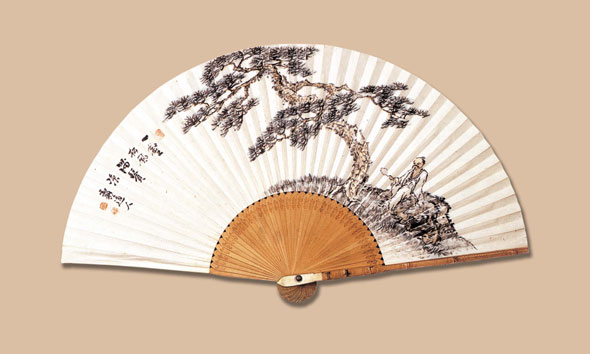 | ||
In every country people have suffered from hot weather. Thus, the fan made for the purpose of easing the heat has become a traditional inheritance in many countries. However, Koreans have built a special custom of writing and painting on fans. According to Jinseo, a Chinese history book, this tradition has existed for about 1,600 years. The fan was widely used among Koreans: from the common to the royal family. According to Do-hwa-gyeon-mun-ji, a Chinese book of art, the Chinese were amazed at the writing and drawing our ancestors drew on their fans. As envoys carried their fans to various countries, foreigners were interested in the way they used them. Eventually, fan culture was spread out to China, Mongolia, and Japan, playing a role in the propagation among Asian countries.
Folding fans were used exclusively by the upper male class while the ladies, and the common people were only allowed to use a round fan. Classical scholars especially used folding fans more as a tool for expressing their dignity than for practical purposes. They mostly carried their own fans during outdoor activities since fans not only represented their class, but were also used as weapons to protect themselves. Regardless of its form, fans were tools that scholars could express their thoughts and feelings through drawing or writing poems. Some were about public ideas such as worries about their country, but most of the subjects were about personal feelings. Meanwhile, during Dano, when the hot weather begins, everybody including the common people gave each other fans. This meant that they hoped the heat would not over power their neighbors. This custom still remains today in the old saying "Fan is favored in summer and calendar in winter."
The fan was loved by everyone throughout Korean history and as a result, gained unique characteristics in the society. Fan dance is a main example. The fan dance emphasize the beauty of Korean traditional fans. It became a huge tradition and has settled well as a stage performance. There are also many varieties of fans. About 100 kinds of fans exist and these can be divided by their forms, materials, and use. For example, uosun is made of bird feathers and jubsun is a folding fan. The royal family used a large fan named yongsun, which was the biggest and coolest fan. "Fans were not just tools for creating wind. They were used as ornaments and have reached the stage of art. We ought to continue to preserve these traditions," says Jo Choong-ik, a human cultural asset of Korea.
As fans have established a unique culture in Korea, they still remain to the present day. This can be seen in the Korean fan dance and also in many events such as the Olympics as a national symbol. In the 2004 Athens Olympics, president Roh gave Korean players hapjukseon, the jeonju bamboo fan, that said "Play well!" as an encouragement. Korean fans did not only appear in the Athens Olympics. Indeed, in every Olympics, Korean players have entered the public square holding round fans in their hands. There are also many fan exhibitions that attract not only Koreans, but also foreigners as well.
Fans are no longer used to express feelings or thoughts. However, the elegance of our ancestors remains in the fans. Our ancestors established creativity through drawings and writings on fans, which is now being proved to be a state of art. Koreans can see the spirit of their ancestors in every fan they come across. Through fans, they can realize the true living story of the past and enjoy the beauty of their ancestors' artistic talents.

